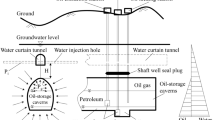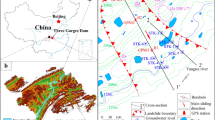Abstract
Time series of natural groundwater level considering rainfall effects are usually used for the estimation of groundwater recharge, long-term trend analysis, and assessment of interactions between surface water and groundwater along rivers. However, anthropogenic activities, such as groundwater pumping, land excavation, and barrier construction, may induce abnormal changes in water levels. This study aimed to develop a universal long short-term memory (LSTM) model for predicting natural water level variations in a time-series record that has been affected by groundwater abstraction or other anthropogenic factors. This model uses past and present groundwater levels, rainfall and representative principal components of groundwater level time series as input variables. For this purpose, 17 cases of the developed LSTM model were tested using 13 monitoring wells, of which the case with the highest prediction performance was selected. Among the test cases, case 6 was found to achieve the highest performance, with average RMSE and MAE values of 0.061 and 0.027, respectively. The case 6 model used rainfall, groundwater level of monitoring wells, and four main principal components (1–4) as input variables. Also, its optimum window size was found to be 5. The accuracy of the LSTM model was found to be more strongly affected by window size than by input variables. Although the case 6 LSTM model may have errors for some monitoring wells, it has high potential as a universal model that can consistently determine natural groundwater levels in South Korea. This LSTM model makes it universally available for water level prediction, even with long missing periods in groundwater level time series or in the absence of adjacent observations for model input.












Similar content being viewed by others
Data availability
Not available.
References
Alley WM (2016) Drought-proofing groundwater. Groundwater 54(3):309–309. https://doi.org/10.1111/gwat.12418
Cai Z, Ofterdinger U (2016) Analysis of groundwater-level response to rainfall and estimation of annual recharge in fractured hard rock aquifers, NW Ireland. J Hydrol 535:71–84
Chung SY, Venkatramanan S, Elzein HE, Selvam S, Prasanna MV (2019) Supplement of missing data in groundwater-level variations of peak type using geostatistical methods. In: Venkatramanan et al (eds) GIS and geostatistical techniques for groundwater science. Elsevier, Amsterdam
Cowen CC, Ferguson PA, Jackman DK, Sexauer EA, Vogt C, Woolf HJ (1996) Finding norms of Hadamard multipliers. Linear Algebra Appl 247:217–235
Gonçalves RD, Teramoto EH, Engelbrecht BZ, Alfaro Soto MA, Chang HK, van Genuchten MTh (2020) Quasi-saturated layer: implications for estimating recharge and groundwater modeling. Groundwater 58(3):432–440
He XH, Ho HV, Lee G, Jung S (2019) Application of long short-term memory (LSTM) neural network for flood forecasting. Water 11(7):1387. https://doi.org/10.3390/w11071387
He L, Chen S, Liang Y, Hou M, Chen J (2020) Infilling the missing values of groundwater level using time and space series: case of Nantong City, east coast of China. Earth Sci Inform 13:1445–1459. https://doi.org/10.1007/s12145-020-00489-y
Hochreiter S, Schmidhuber J (1997) Long short-term memory. Neural Comput 9:1735–1780
HRFCO (Han River Flood Control Office) (2021) Water resources management information system (WAMIS). http://www.wamis.go.kr. Accessed 15 Aug 2021
Jan CD, Chen TH, Lo WC (2007) Effect of rainfall intensity and distribution of groundwater level fluctuations. J Hydrol 332(3–4):348–360
Jiang Y, Guo H, Jia Y, Cao Y, Hu C (2015) Principal component analysis and hierarchical cluster analyses of arsenic groundwater geochemistry in the Hetao basin, Inner Mongolia. Geochemistry 75(2):197–205
Jung H, Koh DC, Kim Y, Ha K, Lee J (2019) Interpretation of groundwater level variations in Jeju Island by principal component analysis. Environ Monit Assess 21:1–1
Killian CD, Asquith WH, Barlow JRB, Bent GC, Kress WH, Barlow PM, Schmitz DW (2019) Characterizing groundwater and surface-water interaction using hydrograph-separation techniques and groundwater-level data throughout the Mississippi Delta, USA. Hydrogeol J 27:2167–2179
Kim GB (2010) Estimation of specific yield using rainfall and groundwater levels at shallow groundwater monitoring sites. J Korea Geo-Environ Soc 11(6):57–67
Kim SG, Kim GB (2019) Are groundwater monitoring networks economical? Cost-benefit analysis on the long-term groundwater supply project of South Korea. Water 11:753. https://doi.org/10.3390/w11040753
Kim GB, Yum BW (2007) Classification and characterization for water level time series of shallow wells at the national groundwater monitoring stations. J Soil Groundwater Environ 12(5):86–97
Kim GB, Son YC, Lee SH, Jeong AC, Cha EJ, Ko MJ (2012) Understanding of surface water-groundwater connectivity in an alluvial plain using statistical methods. J Eng Geol 22(2):207–221
Loukika KN, Venkata Reddy K, Durga Rao KHV, Singh A (2020) Estimation of groundwater recharge rate using SWAT MODFLOW model. In: Ghosh J, da Silva I (eds) Applications of geomatics in civil engineering, vol 33. Lecture notes in civil engineering. Springer, Singapore
MLTMA (Ministry of Land, Transport and Maritime Affairs) (2012) Groundwater management basic plan. Seoul, Korea, 154p (in Korean)
MOE (Ministry of Environment) and K-water (2020) National groundwater monitoring network in Korea - Annual report 2020. Daejeon, Korea, 865p (in Korean)
MOE (Ministry of Environment) (2019) Annual report of groundwater in South Korea. Daejeon, Korea, 372p (in Korean)
Pathak AA, Dodamani BM (2019) Trend analysis of groundwater levels and assessment of regional groundwater drought: Ghataprabha river basin, India. Nat Resour Res 28:631–643. https://doi.org/10.1007/s11053-018-9417-0
Rama F, Miotlinski K, Franco D, Corseuil HX (2018) Recharge estimation from discrete water-table datasets in a coastal shallow aquifer in a humid subtropical climate. Hydrogeol J 26:1887–1902
Ravikumar P, Somashekar RK (2017) Principal component analysis and hydrochemical facies characterization to evaluate groundwater quality in Varahi river basin, Karnataka state, India. Appl Water Sci 7:745–755
Seferli S, Modis K, Adam K (2019) Interpretation of groundwater hydrographs in the West Thessaly basin, Greece, using principal component analysis. Environ Earth Sci 78:257. https://doi.org/10.1007/s12665-019-8262-8
Sun X, Bernard-Jannin L, Garneau C, Volk M, Arnold JG, Srinivasan R, Sauvage S, Sanchez-Perez JM (2016) Improved simulation of river water and groundwater exchange in an alluvial plain using the SWAT model. Hydrol Process 30(2):187–202
Takafuji EHd, Rocha MM, Manzione RL (2019) Groundwater level prediction/forecasting and assessment of uncertainty using SGS and ARIMA models: a case study in the Bauru Aquifer System (Brazil). Nat Resour Res 28:487–503. https://doi.org/10.1007/s11053-018-9403-6
Taylor CJ, Alley WM (2001) Ground water level monitoring and the importance of long-term water level data. US Geological Survey Circular 1217, US Department of the Interior, Denver
Vu MT, Jardani A, Massei N, Fournier M (2021) Reconstruction of missing groundwater level data by using long short-term memory (LSTM) deep neural network. J Hydrol 597:125776. https://doi.org/10.1016/j.jhydrol.2020.125776
Wang W, Zhang Z, Duan L, Wang Z, Zhao Y, Zhang Q, Dai M, Liu H, Zheng X, Sun Y (2018) Response of the groundwater system in the Guanzhong Basin (central China) to climate change and human activities. Hydrogeol J 26:1429–1441. https://doi.org/10.1007/s10040-018-1757-7
Winter TC, Mallory SE, Allen TR, Rosenberry DO (2000) The use of principal component analysis for interpreting ground water hydrographs. Groundwater 38(2):234–246
Yi MJ, Kim GB, Sohn YC, Lee JY, Lee KK (2004) Time series analysis of groundwater level data obtained from national groundwater monitoring stations. J Geol Soc Korea 40(3):305–329
Yoon H, Hyun Y, Ha K, Lee KK, Kim GB (2016) A method to improve the stability and accuracy of ANN and SVM-based time series models for long-term groundwater level predictions. Comput Geosci 90:144–155
Yoon H, Kim Y, Ha K, Lee SH, Kim GP (2017) Comparative evaluation of ANN- and SVM-time series models for predicting freshwater-saltwater interface fluctuations. Water 9(5):323. https://doi.org/10.36390/w9050323
Zamanirad M, Sedghi H, Sarraf A, Saremi A, Rezaee P (2018) Potential impacts of climate change on groundwater levels on the Kerdi-Shirazi plain, Iran. Environ Earth Sci 77:415. https://doi.org/10.1007/s12665-018-7585-1
Zhang J, Zhu Y, Zhang X, Ye M, Yang J (2018) Developing a Long Short-Term Memory (LSTM) based model for predicting water table depth in agricultural areas. J Hydrol 561:918–929
Zhu M, Wang S, Kong X, Zheng W, Feng W, Zhang X, Yuan R, Song X, Sprenger M (2019) Interaction of surface water and groundwater influenced by groundwater over-extraction, waste water discharge and water transfer in Xiong’an new area. China Water 11:539
Acknowledgements
This work was supported by the National Research Foundation of Korea and the Ministry of Science and ICT (No. NRF-2019R1A2C1088085).
Funding
This research is funded by the National Research Foundation of Korea.
Author information
Authors and Affiliations
Contributions
Data curation, M-RC; formal analysis, C-IH; funding acquisition, G-BK; investigation, G-BK; methodology, C-IH; project administration, G-BK; resources, G-BK; supervision, G-BK; validation, G-BK; writing—original draft, G-BK; and writing—review and editing, G-BK.
Corresponding author
Ethics declarations
Conflict of interest
The authors declare no conflict of interest.
Additional information
Publisher's Note
Springer Nature remains neutral with regard to jurisdictional claims in published maps and institutional affiliations.
Rights and permissions
About this article
Cite this article
Kim, GB., Hwang, CI. & Choi, MR. PCA-based multivariate LSTM model for predicting natural groundwater level variations in a time-series record affected by anthropogenic factors. Environ Earth Sci 80, 657 (2021). https://doi.org/10.1007/s12665-021-09957-0
Received:
Accepted:
Published:
DOI: https://doi.org/10.1007/s12665-021-09957-0




